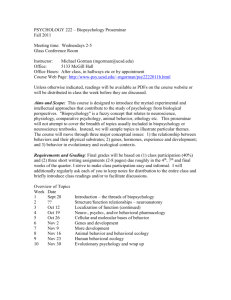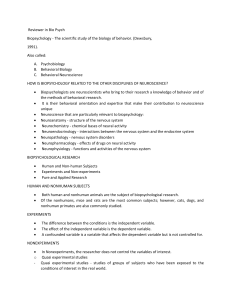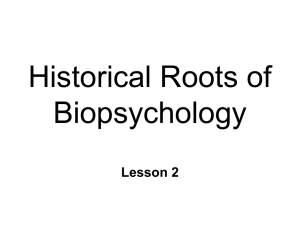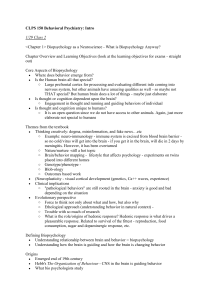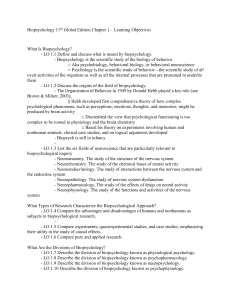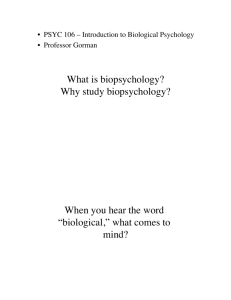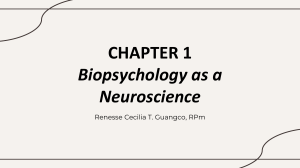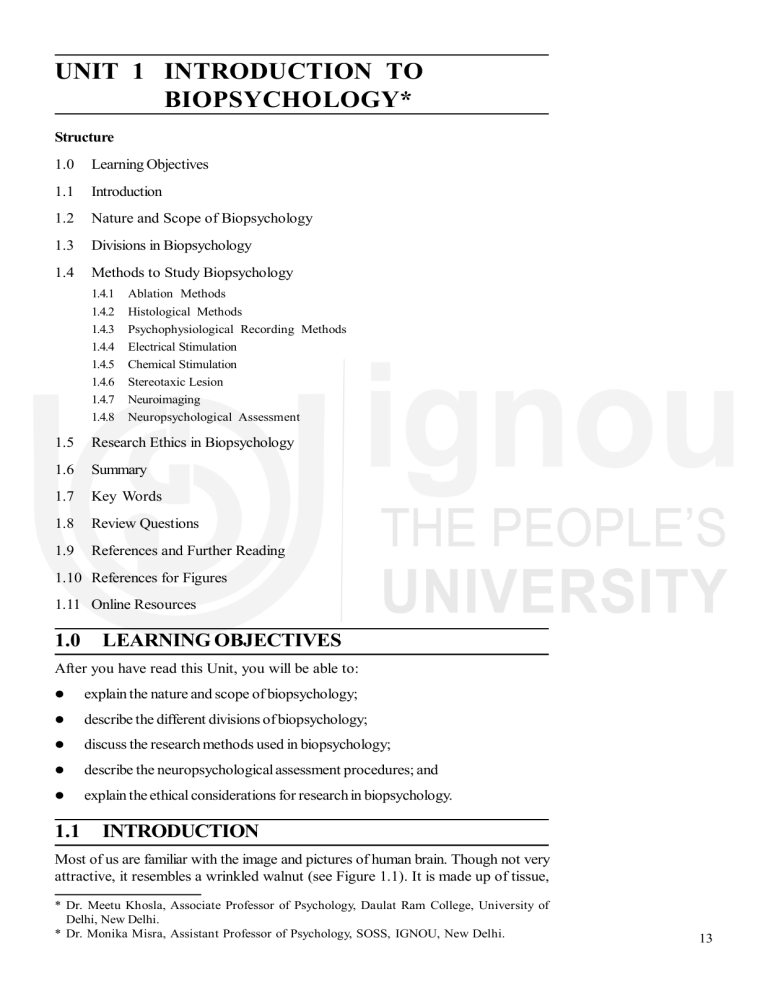
UNIT 1 INTRODUCTION TO BIOPSYCHOLOGY* Structure 1.0 Learning Objectives 1.1 Introduction 1.2 Nature and Scope of Biopsychology 1.3 Divisions in Biopsychology 1.4 Methods to Study Biopsychology 1.4.1 Ablation Methods 1.4.2 1.4.3 1.4.4 1.4.5 1.4.6 1.4.7 1.4.8 Histological Methods Psychophysiological Recording Methods Electrical Stimulation Chemical Stimulation Stereotaxic Lesion Neuroimaging Neuropsychological Assessment 1.5 Research Ethics in Biopsychology 1.6 Summary 1.7 Key Words 1.8 Review Questions 1.9 References and Further Reading 1.10 References for Figures 1.11 Online Resources 1.0 LEARNING OBJECTIVES After you have read this Unit, you will be able to: explain the nature and scope of biopsychology; describe the different divisions of biopsychology; discuss the research methods used in biopsychology; describe the neuropsychological assessment procedures; and explain the ethical considerations for research in biopsychology. 1.1 INTRODUCTION Most of us are familiar with the image and pictures of human brain. Though not very attractive, it resembles a wrinkled walnut (see Figure 1.1). It is made up of tissue, * Dr. Meetu Khosla, Associate Professor of Psychology, Daulat Ram College, University of Delhi, New Delhi. * Dr. Monika Misra, Assistant Professor of Psychology, SOSS, IGNOU, New Delhi. 13 Introduction to Biopsychology weighing only about 1.3 kilograms, but consists of infinite neural connections (neurons) which control all our behaviours. The human brain is highly complicated. It is an organ that is responsible for so many varied tasks and activities ranging from simple to complex, and still, it is the least understood organ of our body. (a) (b) Figure 1.1(a) Dorsal view of human brain (b) Ventral view of human brain The scientific study of the anatomy, biochemical processes and the physiology of nervous system is known as neuroscience. A closely related field of the neuroscience is biopsychology, which draws information from it to study human and animal behaviour. It is also known as psychobiology, behavioural biology or behavioural neuroscience. In this unit, we will discuss about this related branch of neuroscience, that is biopsychology. Major divisions of biopsychology and various methods employed to study it, will be described. Further, we will also discuss about the ethical issues involved in the field of biopsychology. 1.2 NATURE AND SCOPE OF BIOPSYCHOLOGY The biological approach to the study of human and animal behavior is known as biopsychology. The biopsychologists try to investigate scientifically how biological processes interact with cognition, emotions and other psychological processes.We can trace a long history of the study of biology of behavior. But biopsychology as a separate discipline of neuroscience, emerged in the 20th century. D. O. Hebbs' (Canadian psychologist) seminal publication, The Organization of Behaviour in 1949, in the field of psychology and neuroscience, paved the way for future investigation of neural foundations of behavior. What Hebb proposed in 1949, is being applied in the present times in the fields of engineering, robotics, psychology, neuroscience, and neurophysiology. Biopsychology, thus, draws information from neurosciences and uses the information to study human and animal behavior. It may be Figure 1.2: Donald Olding Hebbs better understood as that neuroscience is a team effort and (1904-1985) biopsychologist is a part of this team. A biopsychologist may draw Image Source: https://can-acn.org information from other disciplines of neuroscience and apply it to the study of behavior. Few of the disciplines of neuroscience that are of particular relevance for biopsychology are as follows: 14 Neuroanatomy: It is the study of the structure of the nervous system Neurochemistry: It is the study of chemical aspects of nervous activity Neuropathology: It is the study of disorders of nervous system Neuroendocrinology: It is the study of interaction between the nervous system and endocrine system Neuropharmacology: It studies the impact of drugs on neural activity Neurophysiology: It studies the functions and activities of the nervous system Introduction to Biopsychology So, it may be rightly said that the field of biopsychology is diverse and it is one of the branches that contributes to neuroscience. The research conducted in biopsychology is also from varied perspectives. Biopsychological research is conducted on human or non-human participants. The most common non-human research participants are mice, rats, followed by cats, dogs and primates. There are three advantages in conducting research on non-human participants. The first being, that the brain and behavior of non-human participants is less complex as compared to human participants. Thus, the basic fundamental brain-behaviour interactions may be revealed. Secondly, conducting research on such a group leads to a comparative approach where biological processes of different species maybe compared. Thirdly, it is easy to conduct research on laboratory animals rather than human participants due to ethical reasons, that is there are fewer ethical constraints while we conduct research on animals. Though, the research in Psychology and its branches, are all governed by strict ethical guidelines framed by organizations, like American Psychological Association (Guidelines for Ethical Conduct in the Care and Use of Nonhuman Animals in Research), and Indian Council for Medical Research (ICMR Guidelines for Biomedical Research in India). Research in biopsychology may be a pure research or applied research, and the study is based on empirical investigations with applications for the society. The research can be done using an experimental approach or non-experimental approach or case studies. The scope is to understand the basis of behavior. Behaviour changes are primarily due to disruptions in various brain regions and neural circuits. This may happen because of head injury. Secondly, learning, exercise, etc, also changes the neural structures. So, how it produces a corresponding change in behavioral functions can be studied with the help of various research methods that are used to understand the functioning of the mental processes by examining the biological systems. Biopsychology also aims to understand aspects like, the evolution of brain and its influence on behavior, the development of the nervous system across the life span, which areas of the brain are involved in sensation, perception, memory, movement, the role of brain in emotional expression and regulation, language and cognition, and how the behavioral change occurs after brain damage or trauma. It also seeks to understand the role of genetics and endocrine system in maintenance of homeostasis, and enhancing health and wellbeing of people suffering from various neurological disorders. There has been some very significant research related to brain-behaviour interactions that have been awarded Nobel Prize! You must have read about Ivan Pavlov, a Russian physiologist, in the course Introduction to Psychology(refer to Classical Conditioning). Pavlov was Nobel prize winner in 1904 for his research on physiology of digestion. 15 Introduction to Biopsychology Box 1.1 Pure research: It is also known as basic or fundamental research. It is conducted without any prior aim or goal. It is exploratory in nature and driven by intuition and interest. Applied research: It is conducted with a prior aim. Specifically, it starts with the aim to solve an existing problem. Thus, it is descriptive in nature and has practical implications. This type of research is mainly conducted in technology, medicine, agriculture etc. 1.3 DIVISIONS IN BIOPSYCHOLOGY You have just learned about the nature and scope as well as how research is being conducted in different ways in the area of biopsychology. There are few approaches that gained prominence and consequently separate divisions of biopsychology emerged. Biopsychology has six main divisions such as: physiological psychology, psychopharmacology, neuropsychology, psychophysiology, cognitive neuroscience, and comparative psychology. These approaches are overlapping and many biopsychologists follow more than one approach. Physiological psychology: Physiological psychology uses controlled experimental conditions to stimulate the brain and study its effects on behavior. It involves direct manipulation and recording of the brain by primarily using surgical or electrical stimulation on animals for research. Their aim is to develop theories about how neural mechanisms control behavior. Psychopharmacology: Psychopharmacologists use drugs to stimulate neural systems and then observe their effects on behavior. The purpose is to study the interaction between brain and behavior, but majorly the experiments are applied in nature, focusing on developing therapeutic drugs and reduce drug use. Neuropsychology: Neuropsychologists study the patients who have had some head injury or trauma and are suffering from brain damage. The neuropsychological tests help to diagnose the impairments and work out a suitable treatment for dealing with it. This sub-discipline specially uses case studies and quasi-experimental studies of patients with brain damage caused due to disease, accident or neurosurgery. The focus of these studies is cerebral cortex (you will learn more about this part in Unit 3), the most prominent part of mammalian brain which consists of cellular layers on the outer surface of cerebral hemispheres. Psychophysiology: Psychophysiologists use non-invasive techniques (the physiological activity is recorded from the surface of the body) to examine the relationship between physiological activity and psychological processes as attention, learning, memory, emotions in human participants. Various measures that are used are like, scalp electroencephalogram (EEG), muscle tension, eye movement, galvanic skin response (GSR), heart rate, blood pressure, and pupil dilation. Cognitive Neuroscience: Cognitive neuroscientists study the neural bases of cognition and higher order cognitive processes, like, thinking, memory, attention as well as perceptual processes. Hence, human participants are taken for research. The techniques used are non-invasive. Functional brain imaging is the main method of recording the brain activity. Comparative Psychology: Comparative psychologists study the behavior of different species to understand their behavior from evolutionary, genetic and adaptation perspective. Behaviour is studied in either laboratory condition or it may be observed in its natural environment. The latter is known as ethological research. 16 Introduction to Biopsychology Check Your Progress 1 1) Define biopsychology. ...................................................................................................................... ...................................................................................................................... ...................................................................................................................... ...................................................................................................................... 2) List the main divisions of biopsychology. ...................................................................................................................... ...................................................................................................................... ...................................................................................................................... ...................................................................................................................... 1.4 METHODS TO STUDY BIOPSYCHOLOGY The preceding sections introduced you to the nature, scope and major divisions of biopsychology. This section deals with the methods employed to study human brain. The structure of the brain (see Figure1.1) is quite complex and understanding its working is all the more challenging for the researchers. With the discovery of Broca's area, it was concluded that different brain areas had different functions.In 1861, Paul Broca, French neurologist, found that one of his patients who had lost the ability to speak, had damage in left frontal cortex. More patients with loss of speech showed damage in and around this area, which is now known as Broca's area. Thus, the research conducted in this area concludes that brain damage causes effects like increase or decrease in hunger, changes in emotional responses, to mention just a few. Let us see the main methods used in the study of brain. 1.4.1 Ablation Methods Figure 1.3: Paul Broca discovered a region of the brain responsible for language. Image Source: https://www.nature.com Ablation means removal of a brain area, generally with a surgical knife.It is different from lesion. Both ablation and lesion methods are invasive and involve cutting a part of brain. Ablation method thus, involves the destruction of some tissue in the brain.This is followed by assessing the changes that occur in behavior due to the removal or destruction of the tissue. Any wound or injury thereby, is known as a lesion.But one has to be very careful as different parts of the brain are all connected to one another and work in conjunction with another. So if a lesion is created in one area, it may exert an influence on the neighbouring areas as well. Sometimes the animal also recovers from the brain damage either partially or the functions of the damaged part of the brain are covered up by another part of the brain.There are different ways to cause lesions.The main techniques discussed here are aspiration, radio frequency, knife cuts, cryogenic blockades and nerve poison. Aspiration: A fine thin needle is placed on the tissue (which can be seen by the surgeon and accessible by the instruments) that needs to be examined and it is 17 Introduction to Biopsychology aspirated and the contents are then placed on the slide and examined for any diagnostic analysis.This is generally the preferred technique when a part of the cortical tissue has to be sucked to reveal the area that is under it for further investigation. Radio-Frequency: Radio frequency (RF) current is used to produce sub-cortical lesions. The wire is placed on the tissue which needs to be examined. Radiofrequency devices produce a high frequency current, that is alternating current. The heat that results from this current destroys the tissue in that area. The duration and intensity of the current will determine the size and shape of the lesion. Knife Cuts: Sectioning (Cutting) is used to make a cut on any area of the nerves or the brain. There is a special device that is used to make sub-cortical knife cuts very carefully by placing the brain using a stereotaxic apparatus. By using such a technique, extensive damage to the surrounding area is decreased. Cryogenic Blockade: This is a temporary way of inducing lesions. A cryoprobe is placed in the brain.Through this tube a coolant is sent to the area under study.The coolant reduces the temperatures at its tip to such an extent that the neurons stop sending impulses. Since the temperature is maintained at above freezing point there is no structural damage. Once the temperature is restored to the normal level, the neurons start functioning again. Nerve poison: Certain chemicals such askainic acid or ibotenic acid are used as nerve poisons to create lesions in a particular area in the brain. These chemicals are inserted through a glass tube known as cannula. The destruction is only partial, that is only the cell bodies are destroyed. So, if there is any change in behavior, then that can be attributed to the cell bodies. 1.4.2 Histological Methods With the advent of technology in the present times, there are many techniques and methods to study anatomy and functioning of human brain. For studying minute details of tissue (microscopic investigation), histological methods are used for the purpose. In this method, the sample of the brain that is under investigation, needs to be prepared so that it can be mounted on a slide and observed under a light microscope. The neural tissue is very fragile and under normal conditions it may just disintegrate. Hence, the tissue needs to be fixed and stained inorder to be viewed on the slide. When it is taken out, the bacteria or moulds tend to decompose the neural tissue. Let us now look at the procedures in histological methods. Fixation: In this method, a fixative is used to fix the tissue.The tissue is cleaned and dipped in a fixative solution. The most commonly used fixative is formalin. This fixative prevents autolysis and makes the tissue hard. But still, the tissue is not so hard to be cut using a microtome (automatic slicing machine used in microscopy to produce thin sections of the fixed and embedded tissue for microscopic observations). Hence, the brain tissue is freezed so that the tissue becomes more hard. It is also used to stabilize neural tissue. Box 1.2 : Autolysis 'Auto' means self. Thus, autolysis is the self-digestion or breakdown of cells in animal, plant or microorganism tissue by their own enzymes. 18 Freezing: In freezing, the tissue needs to be frozen, in order to be sliced. To freeze the tissue, it is dipped in a sugar solution and then put in a freezer. The temperature is regulated in a way so that the tissue is maintained at an appropriate temperature. Once the tissue is hard enough, it is to be placed on the microtome to be sliced. Embedding: Another way to make the brain tissue hard is by embedding and covering it by paraffin or nitrocellulose. Once the tissue is hard then it is cut using a microtome. These slices are then placed on a slide and mounted on it using albumin which is taken from the egg. The slide is dried, it is then dyed using different chemical solutions. Staining: It is done so that the structural details of the tissue become apparent under the microscope.This is done by darkening or colouring particular features of the tissue. Nissil stains or cell-body stains are most frequently used to dye the cell bodies. Myelin stains color the myelin sheath to study the nerve pathways. Membrane stains like golgi-cox stain, helps to color the cell body, dendrites and axon. Introduction to Biopsychology 1.4.3 Psychophysiological Recording Methods There are different psychophysiological methods that help to examine human participants in a non-invasive way. Such methods record from outside the skull (and other parts of the body) without inserting anything. The most widely used methods in this category are as follows: Electroencephalography: The electrical activity of the brain is recorded using Electroencephalograph (EEG) machine and the technique is known as electroencephalography. Electrodes are placed on the scalp of the patient and recording is done on the computer. Earlier a rolling paper was used where the readings were displayed, now a computer printout is taken. The EEG signals help in the diagnosis of various disorders of the brain, mild head injury, cerebral pathology, epilepsy, and speed of processing information or how the memory functions with an increase in age. Figure 1.4: EEG and an example of the electrical waves that are read by each electrode Image Source: https://hvmn.com Magnetoencephalography: Also referred as MEG, measures the changes in magnetic fields on the surface of the scalp, produced by changes in the basic patterns of the neural activity. Electromyography: The muscle tension is recorded with the help of electromyogram (EMG). The electrodes are attached to the skin over the muscle that is to be investigated. When the muscle contracts producing muscle tension, it is recorded.This information helps us to know about muscle tone. 19 Introduction to Biopsychology Figure1.5: Electromyogram Image Source: https://medical-dictionary.thefreedictionary.com Electrooculography: The eye movements are recorded by using an electrooculogram (EOG).There is a slight difference in the electrical potential in the back and front portion of the eye ball.This difference in potentials is recorded with the help of electrodes that are placed near the eye. Figure 1.6: The EOG is captured by five electrodes placed around the eyes Image Source: https://www.slideserve.com 20 Electro dermal activity: Two main indices of electro dermal activity are Skin Conductance Level (SCL) and Skin Conductance Response (SCR).Electro dermal activity of the skin is recorded by attaching the electrodes on the fingers and recording the fluctuations in skin conductance. SCL measures the background level of skin conductance associated with a particular situation. SCR is the transient change in skin conductance associated with distinct experiences. When there are different kinds of emotional stimuli, variations are produced in the skin conductance level due to changes in the sweat gland activity. Introduction to Biopsychology Figure 1.7: Skin Conductance Response Image Source: http://www.shurilla.com 1.4.4 Electrical Stimulation The brain can be stimulated electrically to gain information about the working of its various neural systems.When the brain is stimulated, there is a change in the resting membrane potential and an action potential is initiated. This causes behavioral changes depending upon which part of the area has been stimulated. For stimulating the brain electrically, electrodes are used. Microelectrodes are made of fine metal wires through which the nerves are electrically stimulated. Macro electrodes are made of steel wires and are placed either on top of the scalp or inside the brain to record the functioning of tracts, which are large number of neurons together.The electrical recordings can be made over a long period of time, such as when the animal is recovering from any surgery.This is known as chronic recording. If the scientist is focusing to study a particular nerve pathway or where the information is going, then acute recording is done. These recordings of the electrical signals are then displayed through an oscilloscope or ink writing oscilloscope. Oscilloscope: It helps to display the electrical recordings per unit time. It has a cathode ray tube on which the display is done. It is used to record the activity of one single neuron. When the action is detected,it is amplified and easily heard by the researcher. Ink-writing oscilloscope: This is also known as a polygraph.The evoked potentials are recorded with the help of the various electrodes that are attached to the scalp.There are needles/pen tips that record the neural activity on a rolling paper with ink. When the signal is detected, it is amplified and the pens move up and down writing the action in ink on a continuously rolling paper. These recordings of the brain are known as electroencephalogram (EEG). This helps to detect any tumor in the brain, epilepsy or study sleep and arousal pattern. Modern techniques use computer to record the information and display it on the screen. Computer: Helps to display, store and analyse the information that is collected by recording the electrical signals. 1.4.5 Chemical Stimulation There are various ways to chemically stimulate the brain and make lesions. Drugs can 21 Introduction to Biopsychology be given by injections or by inserting a tube into the stomach directly or into a vein or fatty tissue in the body. The chemical activity of the brain can be assessed by using various techniques. One is by using 2- deoxyglucose technique (2-DG). 2-DG is a radioactive drug and when this drug is injected in the animal, the researcher waits till it is absorbed by the brain. Thereafter, the animal is killed and brain is removed and slices are made.Autoradiography is conducted, that is the slices are coated with photographic emulsion. These are then developed as a film. Neurons that have taken the drug appear like black spots on the slide. Another useful technique is cerebral dialysis. A tube is inserted into the animal's brain. The animal is then engaged in an activity and the neuro-chemicals released while the animal is active, are collected and analyzed using the chromatograph. Invivo voltametry is another technique that is used to record the neuro-chemicals released in the animals when they are actively involved in some activity. Immunocytochemistry is a process which helps to locate the presence of neuroproteins in the brain. Each neurotransmitter responds to its specific receptors during a synapse. Microiontophoresis is a process that involves ejection of charged molecules used to apply drugs or chemical to nerve cells. It helps to locate the specific receptors to which the neurotransmitters respond. 1.4.6 Stereotaxic Lesion When ablation is not possible for tiny structures located below the surface of the brain, researchers use sterotaxic techniques to damage a structure in the interior of the brain. First and foremost, it is important to identify which part of the brain needs to be investigated. The sterotaxic atlas helps to locate the exact point of the brain where the surgery has to be done. Once this is done, the animal's head is placed in the head holder of the sterotaxic apparatus. Once the head is firmly held in the apparatus, the electrode holder is used to insert the electrode or cannula into the brain. The electrode can be implanted permanently and when the animal comes out of the effect of anesthesia, behavior is monitored. When the study is over, the animal is given anesthesia again, the electrode is removed and the animal recovers from it. 1.4.7 Neuroimaging Brain imaging is known as neuro-imaging. Structural imaging methods are used to image the structure of the brain.These procedures help to diagnose any injury or disease in the brain as tumors.Functioning imaging helps to understand the function of the brain. It also helps in diagnosing diseases related to metabolism, or brain disorder or disease. 22 X-ray technique: Initially, this technique was used widely to explore the reason behind any neurological deficits. The conventional X-ray did not help much in observing the neural activity of a patient suffering from stroke or neurological disorders. It only provided information about the structures that absorbed the Xray.The cerebral ventricular system and circulatory system within the brain is examined by using the contrast X- ray technique. In this technique, a substance is injected into one compartment of the body that absorbs X-rays either less than or more than the surrounding tissue. This creates a contrast during X-ray photography. Pneumoencephalography and cerebral angiography are two ways in which contrast X-rays are used. The former is a very old radiographic technique to examine the brain. Cerebral angiograms are most useful for localizing vascular damage and help to detect any tumor. Introduction to Biopsychology Figure 1.8: X-ray of a brain Image Source: https://two-views.com Computerized Tomography (CT scan): This is an X-ray technique used along with the computer that helps to view the structures of the body and the brain. There is a huge cylindrical ring in which the person lies down. The X-ray is passed from one side and the X-ray detector is placed on the other side of the patient's head. Slowly the X-ray and the detector are rotated and the photographs are taken from all angles. All the photos are then collected by the computer and a CT scan of the brain is produced. A number of scans are taken and then they are combined to get a 3-D picture of the brain. Neurologists often use CT scans to diagnose blood clots, tumors, sclerosis or any internal injury, etc. and if surgery is to be carried out or not. Figure 1.9: CT scan of brain Image Source: https://www.slideshare.net Magnetic Resonance Imaging (MRI): This technique is used when detailed picture of the patient's brain is to be investigated. This technique uses a strong magnetic field to gather images of the brain in frontal and horizontal planes. Unlike CT scan, it provides more detailed and clearer picture of the brain.This technique helps to know the blood oxygen flow to the different areas of the brain that are active. The resolutions of the images are high and changes are recorded as they occur in real time. It is safe as no injection is given to the patient. 23 Introduction to Biopsychology Figure 1.10: An MRI scan of the human brain provides different views Image Source: http://www.openmrict.com Positron Emission Tomography (PET): PET scan helps to detect the changes in the metabolic activity taking place in the brain.It does not provide any structural information about the brain, rather it provides images of brain activity, that is, functional brain images. It is an invasive method where an injection of radioactive 2- deoxyglucose (2-DG) is given to the patient.When it is absorbed by the patient, the patient is given a task to do and while doing the task, recordings are made. The images recorded show which part of the brain was actively involved in the task. PET scans use radioactive chemicals with a short shelf-life, made in cyclotron (a device to accelerate charged atomic or subatomic particles). It is an expensive technique hence, it is mostly available in research hospitals. Figure 1.11: Brain PET scan Image Source: https://steemit.com 24 Functional MRI (fMRI): It is a less expensive and less risky technique than PET scan. fMRI primarily measures changes in blood flow (hemodynamic response).Currently, it is the most popular method to be used in cognitive neuroscience as well as for medical diagnosis. Diffusion Tensor Imaging (DTI): It is a method that identifies those pathways along which water diffuses. Water diffuses in the tracts (bundles of axons), diffusion tensor imaging gives image of these major tracts. DTI determines the location and also the orientation of neural axons in the brain. This method gives an idea of how the different areas of brain are connected to each other. This is the particular advantage of this technique as compared to other techniques. Introduction to Biopsychology Transcranial Magnetic Stimulation (TMS): It is a technique that turns off a part of cortex by creating a magnetic field. It temporarily inactivates the neurons below the magnet. Researchers use TMS as a mapping technique. For instance, when TMS coil is placed on motor cortex and stimulating different regions along this cortical strip, muscle movements and twitches will be observed on the contralateral side of the body. From this, it can be observed how different body parts map onto different parts of the cortex and also how much cortex is devoted to any particular body part. The main disadvantage of TMS is that it is not very effective in reaching the subcortical structures. Check Your Progress 2 1) What are the different electrical and chemical methods of stimulation? ...................................................................................................................... ...................................................................................................................... ...................................................................................................................... ...................................................................................................................... ...................................................................................................................... 2) List the main brain imaging techniques. ...................................................................................................................... ...................................................................................................................... ...................................................................................................................... ...................................................................................................................... ...................................................................................................................... 1.4.8 Neuropsychological Assessment When we have to assess the amount of impairment in behavior or cognitive capacities after brain injury or damage, we use neuropsychological assessment procedures.Various neuropsychological tests are employed to make an assessment of different cognitive functions such as, learning, memory, discrimination tasks, intelligence, language, perception, decision making, reasoning, etc. The tests are administered, scored and evaluated and a complete mental status of the patient is taken. The neuropsychological assessments include a comprehensive examination of behavioral, psychological, neurological assessment of the patient. These assessments help to get a clinical picture of the patient with respect to his/her cognitive strengths as well as any difficulties that may be there in any cognitive or psychological area. These evaluations help in treating the patient with appropriate medical or rehabilitative procedures. Apart from this, the neuropsychological assessments also provide valid information about the kinds of impairments that may result due to brain damage, injury or trauma 25 Introduction to Biopsychology 26 and how to take care of these deficits. What kind of interventions needed, can be planned to help the client cope with the impairments or how the patient can use other resources to deal with daily life problems. These assessments, thus not only help to diagnose a problem but also provide valuable information about the prospective treatment plan for the patient.The effectiveness of treatment procedures is also assessed so that these programs can be developed to benefit other patients too with similar symptoms. Hence, rehabilitative psychologists can be trained in devising intervention programs for alleviating or dealing with the cognitive impairments after brain injury, tumor, damage, stroke, etc. The psychologist gathers important information from the patient about the history of the illness, the occurrence, severity, developmental milestones, genetics or any other factor that may help in getting a more accurate picture of the patients' problem. Psychologists also use semi-structured interviews to know about the development of the problem.There are various diagnostic tests available for neuropsychological assessments. Few of the common neuropsychological tests used are as follows: Wechsler Intelligence Scale: The first version of this intelligence test was known as Wechsler-Bellevue Intelligence Scale. It was published in 1939 by David Wechsler to measure intellectual performance of adults. These scales have been subsequently been revised for adults and children. The Wechsler Adult Intelligence Scale III (WAIS III) is administered on adults. Wechsler Intelligence Scale for Children-III (WISC-III) is administered on children between the age 6 to 16 years. The Wechsler Preschool & Primary Scale of IntelligenceR (WPPSI-R) is designed for children between the age 4 to 6 ½ years. The Halstead-Reitan Neuropsychological Test Battery: The battery consists of a set of neuropsychological measures which are used by a trained psychologist or a clinical psychologist. The battery is designed to assess all major cognitive, sensory, expressive and motor functions (Reitan, 1986). The test battery is found to be reliable and valid for both younger and older age groups. The Luria-Nebraska Neuropsychological Battery: It is a standardized battery (1986) of neuropsychological tests found to be useful in diagnosing and treatment of brain damage or any brain dysfunction. The test battery is useful for adolescents, adults and older adults. A separate version for children between the ages 8-12 years of age is also available. The major areas covered in assessment are motor, perceptual (auditory, tactile, visual), language (receptive speech, expressive speech), academic (reading, recognition, spelling, writing, arithmetic), memory and intelligence functioning. The Rey-Osterrieth Complex Figure Test: The test was designed by Rey in 1941. It is used to assess visual perception and visual memory in brain damaged individual. It is one of the most used tools to assess constructional abilities and is also used as a non-verbal memory test. Osterrieth (1944) developed norms for children and adults with age range from 4 to 15 years and 16 to 60 years of age. Delis-Kaplan Executive Function System: It is a neuropsychological assessment for executive functions like thinking, inhibition, problem solving, planning, impulse control, concept formation, abstract thinking, and creativity (Delis, Kaplan, & Kramer, 2001). It maybe administered individually or on a group. It is a standardized measure to assess executive functions in children and adults between the age range 8 to 89 years. Digit Span Test: Initially, this test was part of WAIS. The aim of the test is to measure an individual's working memory and assess any impairment of the waking memory. Wisconsin Card Sorting Test: It is a neuropsychological test of 'set-shifting'. It is used to assess frontal lobe dysfunction in patients of brain injury, schizophrenia or any other mental illness. The participant has to sort 64 cards to match either with colour, form or number of figures (Kirby & Silvestri, 2015). The participant is not explicitly told the ‘rule’, but must refer it from the feedback received from the person administering the test. Dichotic Listening Test: Diachotic (di=2; otic=ear) test is non-invasive test. Initially used to investigate selective attention but later, used to assess hemispheric lateralization of language ability. In the standard dichotic listening task, a participant is simultaneously presented with two different auditory stimuli through earphones. Based on the instructions given by the experimenter, results are concluded for the test. Introduction to Biopsychology Figure 1.12: The dichotic listening task Image Source: http://www.indiana.edu 1.5 RESEARCH ETHICS IN BIOPSYCHOLOGY You learned in the first section of this unit, about the Ethical Guidelines to be followed by the researcher. These guidelines have been provided by American Psychological Association and Indian Council of Medical Research, for guidance to the researcher while conducting research with human and animal participants. There are various ethical issues that need to be taken care of while doing research in biopsychology. There are many investigations when one has to explore the parts and functions of the brain, how an incision could influence a particular behavior, how damage to a particular part of the brain could have a psychophysiological impact and so on. For such studies, as well as for studies where there is harm to the person or where survival is at risk, animals are preferred for investigation.When human participants are selected, then the consent is taken from the participant, the doctor(s) treating him/her, therapist,and the caregivers. Whenever it is felt that the experiment is disturbing the participant, or negatively influencing his/her symptoms and aggravating the medical and psychological condition, then the experiment is immediately 27 Introduction to Biopsychology discontinued.When the effects of chemicals, radiation, etc have to be examined on the body, then animals are considered for such studies. Hence, animals are used for those experiments where human beings cannot participate. There are several ethical considerations while doing such experiments. We need to take care of animals during and after the study is over. The conditions of doing an experiment must be well planned, the need for the surgical procedures and equipment must be appropriate.That is to say that animals must be used only when the research in question is of great importance to mankind. No unnecessary harm or pain must be inflicted to the animal. After the experiment is over the animal must be taken care of untill he/she recovers. Check Your Progress 3 1) List the commonly used neuropsychological tests. ...................................................................................................................... ...................................................................................................................... ...................................................................................................................... ...................................................................................................................... ...................................................................................................................... 2) Briefly explain the ethical issues involved in research in biopsychology. ...................................................................................................................... ...................................................................................................................... ...................................................................................................................... ...................................................................................................................... ...................................................................................................................... 1.6 SUMMARY Now that we have come to the end of this unit, let us recapitulate all the major points that we have covered. 28 The biological approach to the study of human and animal behavior is known as biopsychology. The biopsychologists try to investigate scientifically how biological processes interact with cognition, emotions and other psychological processes. Some sub-disciplines of neuroscience are of particular relevance for biopsychology. List of these sub-disciplines include neuroanatomy, neurochemistry, neuropathology, neuroendocrinology,neuropharmacology and, neurophysiology. Research in biopsychology is done with the aim is to understand the basis of behavior and if there is any damage to the nervous system, and how it produces a corresponding change in behavioral functions. Various methods to record and understand brain-behaviour relationship, are ablation, psycho-physiological recordings, electrical and chemical stimulation, stereotaxic lesion, neuroimaging, and neuropsychological assessments. There are various ethical issues that need to be taken care of while doing research in biopsychology. 1.7 Introduction to Biopsychology KEY WORDS Biopsychology : The biological approach to the study of human and animal behavior is known as biopsychology. Ablation : Ablation is a method to study the destruction of tissue in the brain and examining its effect on behavior due to the removal or destruction of tissue. Histological methods : It is the method of scientifically examining the tissue for its structure, function, or pathology. Brain imaging techniques : Also known as neuroimaging, it involves various techniques (such as EEG, PET, MRI, and fMRI scan) to study the structure, function, or pharmacology of the brain. Magnetic Resonance Imaging (MRI) : This technique is used when detailed picture of the patient's brain is investigated. It uses a strong magnetic field to gather images of the brain in frontal and horizontal planes. Physiological Psychology : It is a division/branch of biopsychology. It uses controlled experimental conditions to stimulate the brain and study its effects on behavior. It involves direct manipulation and recording of the brain by primarily using surgical or electrical stimulation on animals for research. Electrooculography (EOG) : It is a method for recording eye movements. Here, the difference in the electrical potential in the back and front portion of the eye ball is recorded with the help of electrodes. Embedding : It is a procedure to make the brain tissue hard by covering it with paraffin or nitrocellulose. 1.8 REVIEW QUESTIONS 1) A technique that uses magnetic fields and radio waves to produce computergenerated images that distinguishes among different types of soft tissue, allows us to see structures within the brain is ....................... . 2) Method of analyzing brain structure by passing narrow X-ray beams through a person's head from several angles to produce measurements from which a computer can construct an image of the brain is known as ....................... . 3) A synonym for experimental ablation is called ....................... . 4) The procedure of ....................... is done so that the structural details of the tissue become apparent under the microscope. 5) Which division of biopsychology relies on functional brain imaging as its major research method? a) psychophysiology 29 Introduction to Biopsychology b) behavioral neuroscience c) neuroimaging d) physiological psychology 6) Why do we need to study biopsychology? 7) Discuss ablation as a method to study biopsychology. 8) How electrical stimulation and chemical stimulation techniques of biopsychology differ from each other? 9) Explain the need to take care of ethical issues while doing research in biopsychology. 1.9 REFERENCES AND FURTHER READING Andreassi, J. L. (2010). Psychophysiology: Human behavior and physiological response. Psychology Press. Breedlove, S. M., Watson, N. V., & Rosenzweig, M. R. (2010). Biological Psychology (pp. 45-46). Sunderland: Sinauer Associates. Ciccarelli, S.K., & White, J.N. (2018). Psychology. Pearson Education Limited. Commins, S. (2018). Behavioural Neuroscience. Cambridge University Press. Ellis, L., &Ebertz, L. (Eds.). (1998). Males, females, and behavior: toward biological understanding. Praeger Publishers. Greene, S. (2013). Principles of biopsychology. Psychology Press. Kalat, J. W. (2015). Biological Psychology. Nelson Education. Khosla, M. (2017). Physiological Psychology: An Introduction. Sage Publication. New Delhi, India. Pinel, J.P., & Barnes, S.J. (2017). Biopsychology. Pearson education. 1.10 30 REFERENCES FOR FIGURES Donald OldingHebbs. RetrievedSeptember 9, 2018, fromhttps://can-acn.org/ donald-olding-hebb Paul Broca: discovered a region of the brain responsible for language. Retrieved September 9, 2018, from https://www.nature.com/articles/446956b A standard setup for an ECG.Retrieved September 10, 2018, fromhttps:// www.medikoe.com/article/Diagnosis-of-hardening-and-narowing-of-the-arteriesATHEROSCLEROSIS-2412 Electromyogram.Retrieved September 10, 2018, fromhttps://medicaldictionary.thefreedictionary.com/electromyogram The EOG is captured by five electrodes placed around the eyes. Retrieved September 110, 2018, fromhttps://www.slideserve.com/danil/testing-of-ocularmotility-evaluation-of-the-extraocular-muscles Skin Conductance Response.Retrieved September 10, 2018, fromhttp:// www.shurilla.com/scr.htm X-ray of a brain. Retrieved September 10, 2018, fromhttps://two-views.com/ xray/brain-test.html CT scan of brain. Retrieved September 10, 2018,fromhttps://www.slideshare.net/ drlokeshmahar/approach-to-head-ct An MRI scan of the human brain provides different views. Retrieved September 10, 2018, fromhttp://www.openmrict.com/mri-brain-scan-whats-involved/ Brain PET scan. Retrieved September 10, 2018, from https://steemit.com/science/ @tushargoel/brain-pet-scan The dichotic listening task. Retrieved September 10, 2018, fromhttp:// www.indiana.edu/~p1013447/dictionary/dichot.htm 1.11 Introduction to Biopsychology ONLINE RESOURCES For more understanding on biopsychology as a subject visit: – http://webs.wofford.edu/steinmetzkr/teaching/Psy230PDFs/Introduction.pdf For information on brain imaging techniques, visit: – https://www.st-andrews.ac.uk/psychology/research/brainimaging/ – https://dana.org/uploadedFiles/Pdfs/brainimagingtechnologies.pdf For an overview on methods to study biopsychology, visit: – http://www.d.umn.edu/~rlloyd/MySite/Physiological%20Psychology/Ch% 205%20phy.PDF – http://www.ecpdu.net/htmlfiles/uploads/2015/01/research-methods-inbiopsychology.pdf For more on ethical issues in biopsychology, visit: – https://www.apa.org/ethics/code/ethics-code-2017.pdf – https://www.apa.org/science/leadership/care/guidelines.aspx – https://www.icmr.nic.in/sites/default/files/guidelines/ICMR_Ethical_Guidelines_ 2017.pdf For a demonstration on surgical implantation, visit: – https://www.jove.com/video/3565/surgical-implantation-chronic-neuralelectrodes-for-recording-single Check your answers for Multiple Choice Questions (1) MRI, (2) CT scan, (3) Lesion study, (4)Staining, (5) Neuroimaging 31
